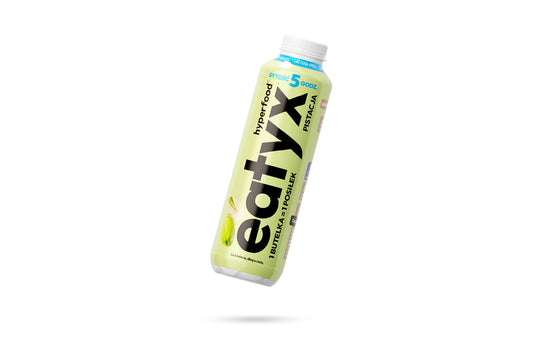Lactose intolerance is an unpleasant condition that causes a number of unpleasant symptoms and forces huge restrictions in the diet. However, it is worth knowing that even in this case you can maintain a healthy, well-balanced and, what is equally important, tasty diet. What is lactose intolerance? What helps with this condition? What are the symptoms of lactose intolerance? In this article we answer each of these questions.
For people who do not experience this condition, lactose indigestion may seem like a trivial problem. "Just avoid milk and milk products and the problem will be solved." In practice it is not that simple. You need to know that milk is present not only in cheese and other dairy products, but also in food that theoretically should not contain it. Just point to meat products. An elimination diet, which is what people with lactose intolerance must implement, poses a serious risk of deficiencies, both in the area of micro- and macroelements. Fortunately, even people suffering from this condition can eat healthy and tasty food. Healthy ready-made meals will help with this, such as the full-value eatyx powdered meal . A properly composed diet will take care of the body's needs and will prevent the symptoms of intolerance from occurring.
Lactose intolerance – what is it?
When talking about lactose intolerance, we mean a clinical syndrome that manifests itself with characteristic symptoms that occur after consuming products containing lactose, i.e. the so-called milk sugar . This term covers the basic ingredient of milk of almost all mammals (the only exception is sea lion milk, in which lactose occurs in trace concentrations). Apart from proteins and fats, it is the basic source of energy for children fed with mother's milk.
This ingredient is not absorbed from the digestive tract . Lactose is digested by its decomposition into simple sugars: glucose and galactose. This process is carried out by an enzyme called lactase, which occurs in the small intestine . If its concentration is too low, lactose will not decompose and will not fulfill its biological functions. This condition is called lactose intolerance.
The inability to effectively use this ingredient by the body is not the only result of this condition. People with this condition experience extremely unpleasant symptoms of lactose intolerance after each consumption of milk, dairy products or products containing this ingredient.
It is worth mentioning here that the term "lactose intolerance" is often used interchangeably with the term "lactose allergy". However, we must emphasize that they are not the same. Intolerance is a condition caused by a deficiency of the enzyme lactase. In turn, food allergy to milk is caused by hypersensitivity of the immune system to the proteins contained in it.
Lactose intolerance – causes
There is no single cause of this condition. In most cases, lactose intolerance is primary . This means that it is related to the physiological process of decreasing the activity of the lactase enzyme and genetic predispositions.
While the primary form is one of the most common, we must emphasize that there are also other causes of lactose intolerance. We are talking about congenital or acquired factors.
Lactose intolerance – causes:
- congenital conditions : in this case, genetic conditions are responsible for the complete lack of the lactase enzyme, and the consumption of even the smallest amount of lactose may be dangerous to health;
- secondary conditions : this condition accompanies diseases in which the intestinal epithelium and villi, responsible for the production of the enzyme, are damaged.
In each form of this condition, symptoms of lactose intolerance appear. The symptoms are unpleasant and bothersome, and we cannot help but mention that when they repeat frequently, they may cause further health problems. How does lactose intolerance manifest itself?
Lactose intolerance – symptoms
The symptoms that occur are a direct result of reduced activity or complete absence of the lactase enzyme. As a result of this disorder, the digestion of lactose in the small intestine becomes impossible. Undigested, it accumulates in the digestive tract and is used by intestinal bacteria.
Lactose intolerance – symptoms:
- flatulence,
- excess gases,
- feeling of overflow in the intestines,
- abdominal pain (resulting from irritation of the intestinal mucosa),
- colic,
- feeling of fullness,
- diarrhea.
Lactose intolerance – treatment and nutrition
We have already explained what lactose intolerance is. We have listed the symptoms of intolerance above. It's time to answer another important question: what about lactose intolerance?
Unfortunately, there is no effective method of treating this condition. If you consume food with lactose, you can take a preparation with lactase. This will help you avoid unpleasant symptoms, but it is only a temporary method that does not bring lasting effects.
The basis of treatment in the event of this condition is the implementation of an elimination diet. Milk, milk products and any products containing lactose should be excluded from the menu. Currently, patients are in a quite comfortable situation, because there is no shortage of substitutes on the market in which lactose is broken down into simple sugars in special technological processes.
However, this does not solve the problems of people who, for various reasons, cannot or do not want to prepare meals themselves. In their case, eating in bars and restaurants poses a significant risk. Catering for a lactose-free diet is not cheap. Is there any alternative? Of course. Our offer consists of ready-made meals that do not contain lactose . Food poured with boiling water is completely safe for people who do not tolerate this ingredient, just like a meal replacement cocktail.
Eatyx products, such as eatyx COMPLETE CHOCOLATE MEAL (LARGE PACK 15 SERVINGS), are characterized by high calcium content. This is important because a diet eliminating lactose poses a high risk of deficiency of this mineral. They also contain other micronutrients that cannot be missing in a properly balanced menu. Suffice it to say that eatyx BALANCED COMPLETE MEAL READY TO EAT VANILLA 500ML contains as many as 24 essential vitamins and minerals.



